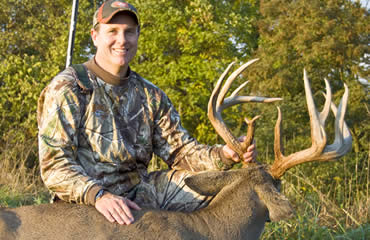Last week we shared tips for taking magazine quality field photos, techniques used by hunting industry professionals, and the frustrations of magazine editors over bad field photos.
Field photos, also known as grip-and-grins, are photos of hunters posing with their freshly killed animals, usually taken by a friend or relative of the hunter.
This week, we’ll explore a technique used by Buckmasters cameramen, editors and professional writers to clean up a freshly taken animal that will also make taxidermists happy.
These tips will help the average hunter take amazing photos while their trophy is still fresh.
Tilt and Cleanse for Better Photos (and Taxidermy)
One of the first things Buckmasters cameramen, editors and outdoor writers do when preparing a downed buck for picture-taking is to clean it up. They also take quick measures to prevent blood from coming out of the mouth while preserving the cape at the same time.
Generally, the tongue is removed first. Next, all blood is wiped away with Windex spray and paper towels, or Windex wipes. Baby wipes are also effective.
These products are usually scented, so we store them in our camera bags, not our backpacks.
Keeping the deer’s head elevated and tilted back prevents additional blood from running out.
An elevated head directs blood down the windpipe instead of the mouth until your photographer is ready to start snapping.
While setting up a good field photo, it helps to have an extra person keep the deer’s head up and tuck the legs underneath the animal while the hunter gets in to position. This helper can also hand things to the hunter and assist the photographer.
Pull long weeds and remove all sticks or obstructions that might impede the shot.
Roll the trophy up on its belly and tuck its legs, with the hunter using his or her thigh and knee to prevent it from tipping over.
Hand your hunter the gun or bow if they desire to have it in the shot, or lay it down next to the hunter.
If the hunter can’t hold the firearm with one hand while lifting the animal’s head the other, help them sling the gun to a shoulder.
NEVER lay a firearm on the animal. It’s nearly impossible to do this without the muzzle pointing back toward the subject, so just DON’T DO IT.
Windex and wipes work like magic for taking blood off a deer’s face, but a wipe-down with chemicals serves another important function.
From the moment an animal dies, bacteria begin to attack its cape — especially in places where blood or fluids have saturated hair.
Hair slippage occurs after an animal is mounted. Years later, hair will pull or fall out easily because the hunter allowed bacteria to set into the cape after harvest.
Windex and wipes contain bacteria killers and help preserve the animal’s cape before your taxidermist even sees it, so wipe it down good, even if there isn’t much blood.
Your prized trophy mounts will last much longer if you take that step today.
Read Recent Tip of the Week:• Take Great Field Photos: Part One: A few pro tips ALL hunters can use to take amazing photographs.




.png)